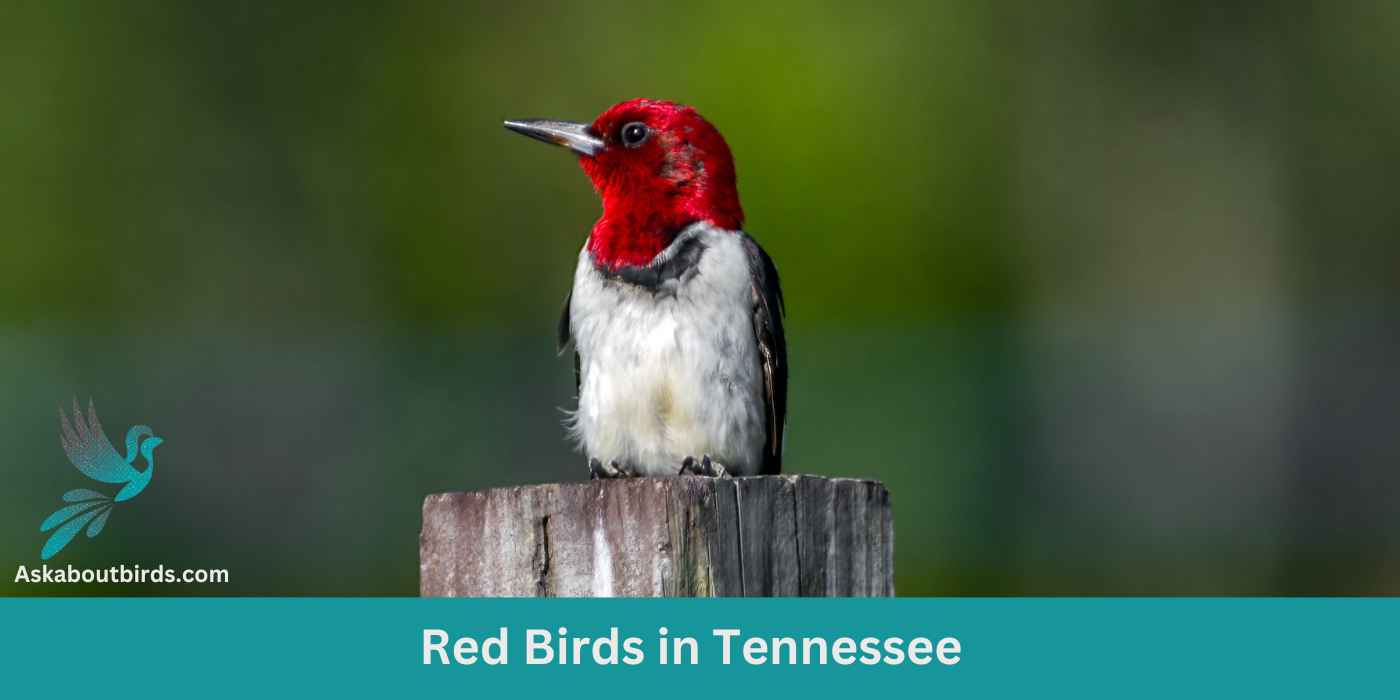Nestled in the heart of the American South, Tennessee’s diverse landscapes provide a vibrant tapestry for birdwatchers. From the rolling Appalachians to its verdant valleys, the state is a haven for a myriad of colorful avian species.
Dive into this guide and discover 11 radiant red birds in Tennessee that graces the skies, and as a bonus, enjoy our complimentary photo guide to help you identify and appreciate each one in its natural splendor.
Red Birds Found In Tennessee
Tennessee is characterized by its rolling hills, dense forests, and the mighty Mississippi River lining its western edge. The diverse topography of Tennessee, from the Appalachian Mountains in the east to the Mississippi River floodplains in the west, provides a mosaic of habitats that attracts a wide variety of bird species.
The state’s position in the migratory path known as the Mississippi Flyway further enhances its avian diversity.
Northern Cardinal


| Feature | Measurement |
|---|---|
| Scientific Name | Cardinalis cardinalis |
| Length | 8.3 – 9.1 in |
| Wingspan | 9.8 – 12.2 in |
| Weight | 1.19 – 2.29 oz |
The Northern Cardinal is an iconic North American bird, easily recognized by its vibrant color and melodious song.
Appearance: Male Northern Cardinals are a brilliant scarlet red, while females display a more subdued reddish olive. Both sexes have a distinctive black ‘mask’ on their face around the bill and a pointed crest on their head. The bird’s beak is robust, cone-shaped, and bright orange in color.
Diet: Northern Cardinals are primarily granivorous, with a diet largely consisting of seeds and grains. They also eat fruits and insects. These birds typically feed off the ground and are frequent visitors to bird feeders.
Reproduction: Northern Cardinals are monogamous, and a pair will breed together for life. The female typically builds a well-hidden nest in a dense thicket or shrub. She lays 2-5 eggs per clutch, which she incubates for around two weeks.
Summer Tanager


| Feature | Measurement |
|---|---|
| Scientific Name | Piranga rubra |
| Length | 6.7 in |
| Wingspan | 28 to 30 cm |
| Weight | 29 g |
The Summer Tanager is a medium-sized songbird admired for its radiant plumage and melodious song.
Appearance: Male Summer Tanagers are an impressive bright red, while females and juveniles present a softer, yellow-orange color. Both genders have a large, slightly hooked bill and relatively short tail.
Diet: Summer Tanagers primarily feed on insects, including bees and wasps, which they catch in flight or pick off vegetation. They are also known to eat fruits and berries, making them helpful in controlling pest populations and seed dispersal.
Reproduction: The female Summer Tanager builds a loose, shallow cup-shaped nest out of twigs and grass, usually hidden in the foliage of trees. The female typically lays 3-5 eggs, which she will incubate for about two weeks.
Scarlet Tanager


| Feature | Measurement |
|---|---|
| Scientific Name | Piranga olivacea |
| Length | 6.3 to 7.5 in |
| Wingspan | 9.8 to 11.8 in |
| Weight | 23.5 to 38 g |
The Scarlet Tanager is a strikingly colorful bird known for its brilliant plumage and distinctive song.
Appearance: Male Scarlet Tanagers are notable for their vibrant scarlet bodies contrasted with black wings and tail, making them one of the most intensely colored birds. Females and juveniles, on the other hand, have a subdued olive-yellow body color with darker wings and tail.
Diet: The diet of the Scarlet Tanager is largely made up of insects, including beetles, cicadas, aphids, and others. They are adept flycatchers, seizing insects in mid-air or picking them off foliage. They also consume fruits and berries, especially during migration and in their winter habitats.
Reproduction: The female Scarlet Tanager builds a cup-shaped nest using twigs, rootlets, and grass, typically well-hidden in the dense foliage of trees. She lays 3 to 5 eggs and incubates them for about two weeks.
Red-headed Woodpecker

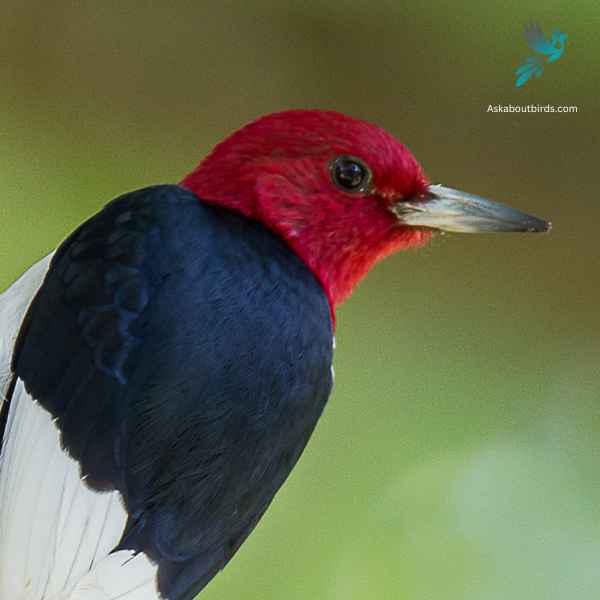
| Feature | Measurement |
|---|---|
| Scientific Name | Melanerpes erythrocephalus |
| Length | 7.5–9.1 in |
| Wingspan | 16.5 in |
| Weight | 2.0–3.2 oz |
The Red-headed Woodpecker is a striking forest bird with a bold tri-colored pattern.
Appearance: This woodpecker features a completely red head and neck, contrasting starkly with its white underparts and black wings. Its wings also have large white patches which are conspicuous in flight.
Diet: Red-headed Woodpeckers have a varied diet including insects, seeds, fruits, berries, and occasionally even the eggs of other birds. They’re also known to store food by wedging it into crevices in bark.
Reproduction: These woodpeckers nest in cavities which they excavate in dead wood or dead parts of live trees. These cavities can be found anywhere from 2 to 80 feet off the ground.
Red-bellied Woodpecker
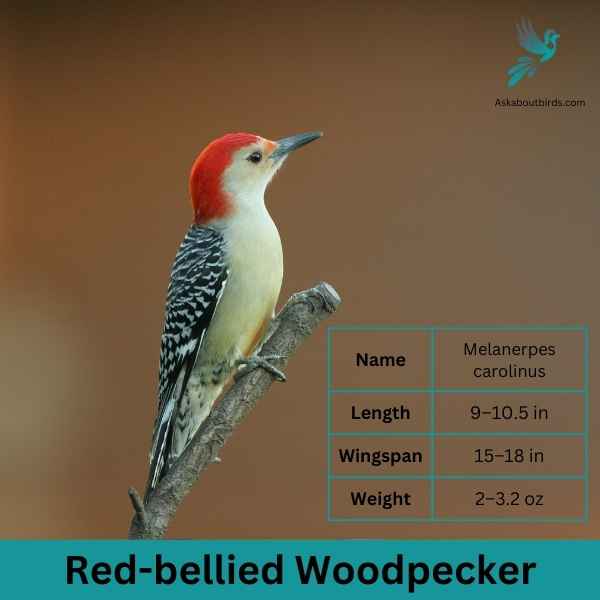
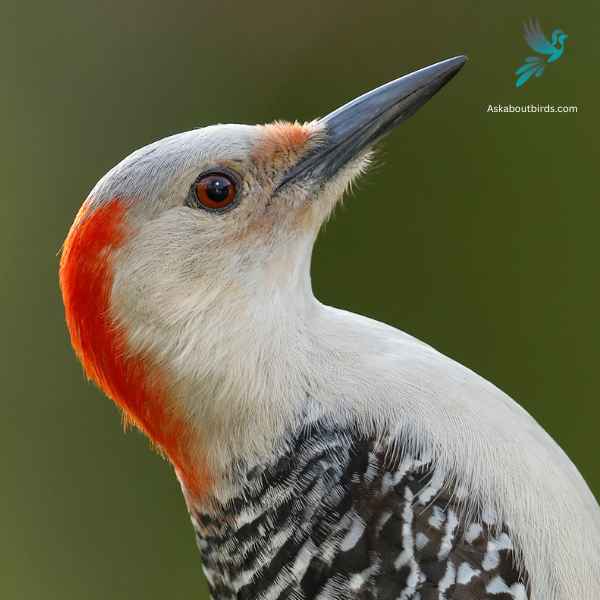
| Feature | Measurement |
|---|---|
| Scientific Name | Thryothorus ludovicianus |
| Length | 4.7–5.5 in |
| Wingspan | 11 in |
| Weight | 0.63–0.81 oz |
The Red-bellied Woodpecker is a medium-sized woodpecker commonly found in woodlands, forests, and backyards across the eastern and central U.S.
Appearance: The Red-bellied Woodpecker sports a pale gray face, throat, and belly, contrasted by a zebra-striped back. Its name derives from the subtle reddish tinge on its belly, but it’s more commonly recognized by the vivid red cap on the head of males and the partial red cap on females.
Diet: This woodpecker has a varied diet that includes insects, fruits, nuts, and seeds. They frequently forage on tree trunks and branches, using their sticky, barbed-tipped tongue to extract ants, beetles, and other insects from crevices.
Reproduction: Red-bellied Woodpeckers are cavity nesters, excavating holes in tree trunks for their nests. The inside of the nest is typically unlined or sparingly lined with wood chips.
Pine Grosbeak

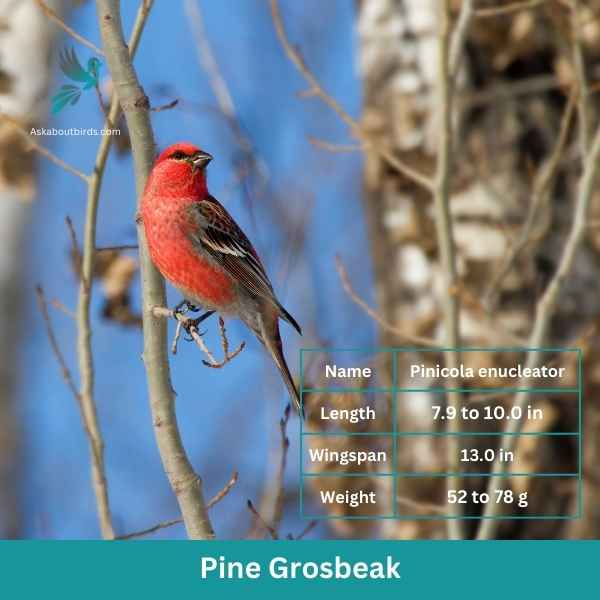
| Feature | Measurement |
|---|---|
| Scientific Name | Pinicola enucleator |
| Length | 7.9 to 10.0 in |
| Wingspan | 13.0 in |
| Weight | 52 to 78 g |
The Pine Grosbeak is a striking bird native to the northern regions of North America, often found in coniferous forests. Both males and females have a plump and robust body with a large beak adapted for eating seeds. The male Pine Grosbeak displays a vibrant reddish-pink plumage, while the female has a more subdued grayish-brown coloration.
These birds are typically seen in small flocks, foraging for food in trees and on the ground. They have a preference for seeds, particularly those from various conifer species. The Pine Grosbeak uses its strong bill to crack open the cones of tall trees and extract the seeds, but they also consume berries and small fruits when available.
House Finch


| Feature | Measurement |
|---|---|
| Scientific Name | Haemorhous mexicanus |
| Length | 5–6 in |
| Wingspan | 8–10 in |
| Weight | 0.6–0.9 oz |
The House Finch is a small songbird widely distributed across North America and is commonly found in urban and suburban areas.
Appearance: Males of this species are brightly colored with crimson faces and throats, which can extend to the chest and back, while their flanks have streaks. The female is streaked brown and lacks the red coloring. Both have a square-tipped tail and a distinctively long, flat-topped bill.
Diet: House Finches primarily eat seeds, grains, and berries. They have a particular fondness for sunflower seeds and can be commonly seen at bird feeders. Occasionally, they will also consume insects, especially during the breeding season.
Reproduction: House Finches are cavity-nesters and might choose ledges, vents, ledges, and other urban settings. They might also utilize trees or shrubs. Their nests can be made of a wide array of materials, from feathers to twigs.
Red-Winged Blackbird
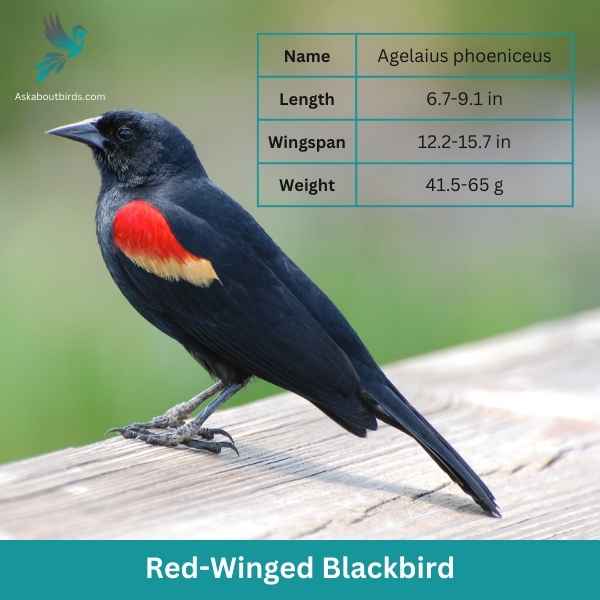
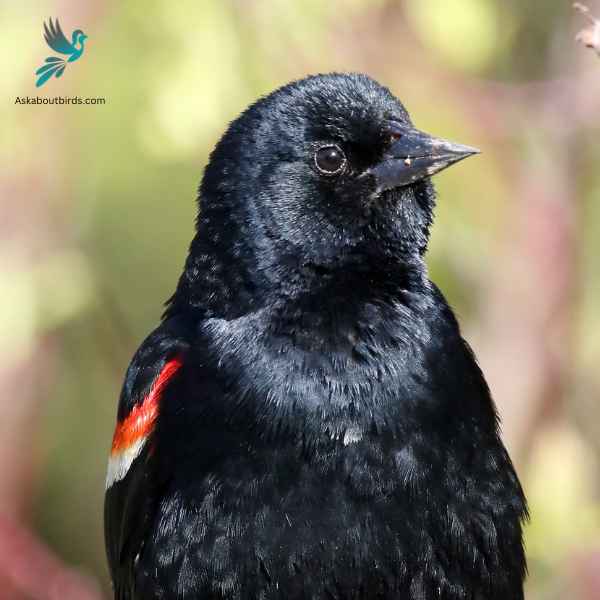
| Feature | Measurement |
|---|---|
| Scientific Name | Agelaius phoeniceus |
| Length | 6.7-9.1 in |
| Wingspan | 12.2-15.7 in |
| Weight | 41.5-65 g |
The Red-Winged Blackbird is a familiar sight across North America, especially in wetlands and open areas. Known for its striking coloration and distinct call, it is often seen perched on cattails or utility lines.
Appearance: Male Red-Winged Blackbirds are glossy black with bright red-and-yellow shoulder patches, while females are streaky brown, resembling a large sparrow. The males’ red patches become more prominent when they’re displaying or agitated.
Diet: Red-Winged Blackbirds primarily feed on seeds and insects. Their diet includes grains, sunflower seeds, and corn, but they also eat beetles, caterpillars, and other small invertebrates, especially in the breeding season.
Reproduction: Red-Winged Blackbirds nest in marshes, along watercourses, and in wet fields. The female constructs a cup-shaped nest using grass and sedge, attaching it to plants above water. She typically lays a clutch of 3 to 4 blue-green eggs, which she incubates for about 11-12 days. Males, being polygynous, often have multiple mates during a single breeding season.
Eastern Towhee

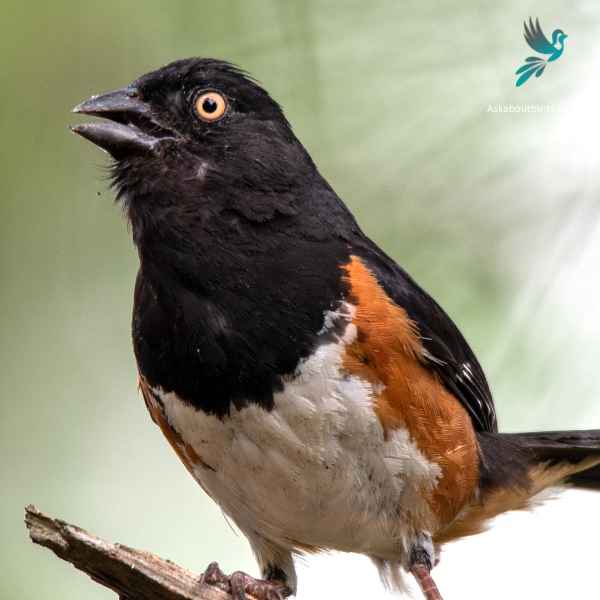
| Feature | Measurement |
|---|---|
| Scientific Name | Pipilo erythrophthalmus |
| Length | 6.8 to 9.1 in |
| Wingspan | 7.9–11.8 in |
| Weight | 32 to 53 g |
The Eastern Towhee is a distinctive songbird known for its unique calls and eye-catching coloration.
Appearance: Male Eastern Towhees are characterized by a striking combination of a black head, back and tail, contrasting with a white belly and rufous flanks. Females sport similar patterns but instead of black, they have a rich brown color. Both genders have red eyes, lending a special charm to their overall appearance.
Diet: Eastern Towhees primarily feed on a variety of insects, seeds, and berries. Their diet is quite diverse, taking advantage of seasonal offerings, which includes beetles, caterpillars, spiders, acorns, grass seeds, and various fruits and berries.
Reproduction: Eastern Towhees build their nests on or near the ground, often in a shrub or a small tree. The female lays around 3-5 eggs and takes the primary role in incubating them over about 12-13 days.
Red Crossbill

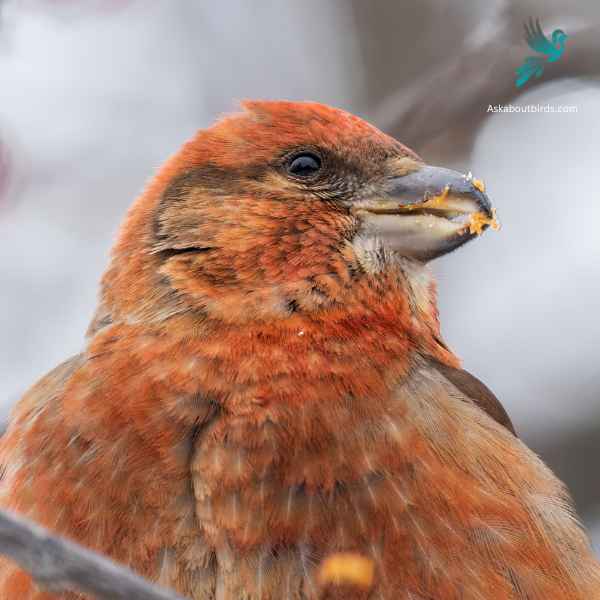
| Feature | Measurement |
|---|---|
| Scientific Name | Loxia curvirostra |
| Length | 5.5–7.5 in |
| Wingspan | 9.8–10.6 in |
| Weight | 0.9–1.4 oz |
The Red Crossbill is a distinctive finch known for its unusual bill, which has evolved to extract seeds from conifer cones.
Appearance: Males are typically bright red or orange, while females are greenish-yellow or olive. Both genders have the characteristic crossed bill, which they use to expertly extract seeds from tightly closed conifer cones.
Diet: Red Crossbills primarily feed on the seeds of coniferous trees, such as spruce, pine, and fir. Their specialized bills allow them to efficiently pry apart conifer cone scales to access the seeds.
Reproduction: Red Crossbills are somewhat nomadic and don’t adhere to a strict breeding schedule. Instead, they breed whenever and wherever food is abundant. Their nests are usually built on horizontal branches of conifer trees.
American Robins


| Feature | Measurement |
|---|---|
| Scientific Name | Leptotila plumbeicep |
| Length | 10.6-11.8 in |
| Wingspan | — |
| Weight | 160-200 g |
The American Robin is a widely recognized bird species known for its melodious song and early bird tendencies.
Appearance: American Robins are medium-sized birds with a distinctive appearance. Both males and females sport a gray to brown back and a warm red to orange breast and belly and gray wings. They also have a characteristic white eye-ring and a black head, but males are usually darker than females.
Diet: American Robins have a diverse diet that changes depending on the season. In summer, they feed heavily on earthworms, beetles, and other invertebrates, which they catch on the ground. During winter, they mostly eat fruits and berries.
Reproduction: American Robins usually build their nests in trees or shrubs, but they are also known to nest on human-made structures. The female lays a clutch of about 3 to 5 eggs, which she incubates for about 12 to 14 days.
Where to Spot Tennessee’s Red Birds
Tennessee’s varied terrains and habitats have made it a haven for birdwatchers, and for those with a penchant for red birds, there are a few locations that stand out as must-visits.
- Great Smoky Mountains National Park: As the most biodiverse national park in the United States, the Great Smoky Mountains offer a remarkable range of avian species. Its elevational gradient and diverse habitats make it especially great for spotting different red birds throughout the seasons.
- Radnor Lake State Natural Area: Located near Nashville, Radnor Lake is a serene spot that boasts more than 240 species of birds. The lake and surrounding woodlands make it an excellent place for spotting waterfowl, songbirds, and especially red birds during migrations.
- Reelfoot Lake State Park: Created by a series of earthquakes, Reelfoot Lake is a unique natural habitat with its cypress swamps and flooded forests. A top spot for water birds, it’s a wintering ground for bald eagles and a great location to see a diverse array of red bird species.
- Shelby Farms Park: One of the largest urban parks in America, located in Memphis, it offers a blend of forests, lakes, and wetlands. The park is a hotspot for various bird species, making it an ideal place for birdwatchers looking to spot red birds without venturing far from the city.
- Hiwassee Wildlife Refuge: Situated on the Hiwassee River, this refuge is a wintering ground for thousands of sandhill cranes and many other bird species. Its mix of wetlands and forests offers birdwatchers an opportunity to see a variety of red birds in a concentrated area.
| State’s Red Birds | Top Birdwatching Spots |
|---|---|
| Kentucky’s Red Birds | 1. Mammoth Cave National Park 2. Red River Gorge 3. Lake Cumberland |
| Virginia’s Red Birds | 1. Shenandoah National Park 2. Chincoteague National Wildlife Refuge 3. First Landing State Park |
| North Carolina’s Red Birds | 1. Cape Hatteras National Seashore 2. Pisgah National Forest 3. Pea Island National Wildlife Refuge |
| Georgia’s Red Birds | 1. Okefenokee Swamp 2. Cumberland Island National Seashore 3. Cohutta Wilderness |
| Alabama’s Red Birds | 1. Wheeler National Wildlife Refuge 2. Dauphin Island 3. Bankhead National Forest |
| Mississippi’s Red Birds | 1. Noxubee National Wildlife Refuge 2. Gulf Islands National Seashore 3. Delta National Forest |
| Arkansas’s Red Birds | 1. Hot Springs National Park 2. Buffalo National River 3. Ouachita National Forest |
| Missouri’s Red Birds | 1. Ozark National Scenic Riverways 2. Mark Twain National Forest 3. Swan Lake National Wildlife Refuge |
FAQs on Red Bird Species Found in Tennessee
What distinct features identify the purple finch from other birds?
The purple finch, contrary to its name, doesn’t exhibit purely purple tones. Instead, it’s a bright red bird for the males, while females showcase brown plumage. These medium-sized birds exhibit two white wing bars and a pale bill. Their tail feathers are well-proportioned, making them commonly spotted at backyard bird feeders. Their preference for black oil sunflower seeds makes them year-round residents in certain areas.
How does the habitat of the purple finch differ from the ruby throated hummingbird?
While both the purple finch and the ruby throated hummingbird can be found in forested regions, their specific habitats differ slightly. The purple finch is more inclined towards forest edges, especially those with shade trees. In contrast, ruby throated hummingbirds, with their vibrant green wings and distinctive red plumage, are often found flitting through the forest canopy, especially in Central America. Both birds, however, relish the sanctuary provided by trees.
Are purple finches found alongside rose breasted grosbeaks?
Purple finches and rose breasted grosbeaks often share similar habitats. These medium-sized birds, with their respective bright red and rose-colored plumage, can be seen in areas with dense tree cover, including pine oak woodlands and spruce trees. Both species have a particular fondness for conifer seeds and are known to visit backyard bird feeders, especially when stocked with black oil sunflower seeds.
Do purple finches migrate to South America like some other bird species?
While some bird species, such as the painted bunting with its yellow-green and orange birds hue, migrate to South America, purple finches are primarily year-round residents in specific regions. They tend to reside in areas from southern Canada to the northern United States. However, during certain times, especially in search of food, some flocks might venture further, but such migrations are not as extensive as other species like the palm warbler.

